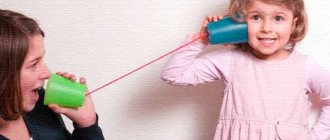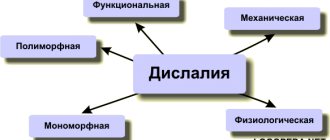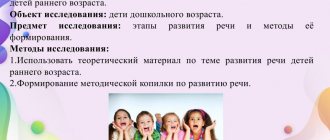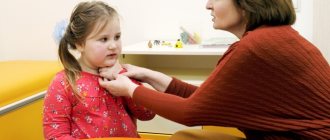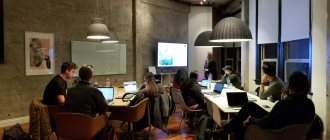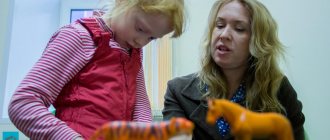After two years of life, speech plays the main role in the development of the psyche and the formation of behavior. There are various forms of child speech development. If up to two years of age a child used 300 words in his speech, then, subject to skillful pedagogical influence, up to three years of age the vocabulary expands to 1000 or more words.
Expanding his life experience under the guidance of an adult, a child of 2-3 years old learns to establish elementary cause-and-effect relationships between objects of the external world, understands and poses many different questions himself.
One of the effective forms of developing a child’s speech is daily individual communication with him. With his questions and answers to the child’s remarks, the teacher provides him with information that requires additional clarification. In the process of such communication, you can suggest a new word to the child and help build a simple language structure.
Complex classes
A complex lesson in its structure combines at least three speech tasks. Tasks for the development of communicative activity (dialogical and coherent speech) are implemented at each of them; tasks of vocabulary work, sound culture of speech and grammatical structure of the language as part of a complex lesson are planned twice a month. The teacher himself determines which part of the lesson to start from, depending on the complexity of the tasks and the age of the children.
Approximate structure of a complex lesson: I week - communicative activity + sound culture of speech + grammar; Week II - communicative activity + grammar + vocabulary; Week III - communicative activity + vocabulary + sound culture of speech.
TYPES OF SPEECH DEVELOPMENT CLASSES
ORIGINALITY OF SPEECH DEVELOPMENT CLASSES
Classes on speech development and literacy training differ from others in that the main activity in them is speech. Speech activity is associated with mental activity, with mental activity. Children listen, think, answer questions, ask them themselves, compare, draw conclusions and generalizations. The child expresses his thoughts in words. Difficulty of classes
lies in the fact that children simultaneously engage in different types of mental and speech activity: speech perception and independent speech operation. They think about the answer, select from their vocabulary the right word that is most suitable in a given situation, form it grammatically, and use it in a sentence and coherent statement.
The uniqueness of many speech development activities
is the internal activity of children: one child tells, the others listen, outwardly they are passive, internally active (they follow the sequence of the story, empathize with the hero, are ready to complement, ask, etc.). Such activity is difficult for preschool children, since it requires voluntary attention and inhibition of the desire to speak out.
Lesson effectiveness
Speech development is determined by how fully all the program tasks set by the teacher are implemented and ensures that children acquire knowledge and develop speech skills and abilities.
TYPES OF SPEECH DEVELOPMENT CLASSES
depending on the leading task:
· classes on vocabulary formation (for example, inspection of the premises, familiarization with the properties and qualities of objects);
· classes on the formation of the grammatical structure of speech (for example, the didactic game “Guess what is missing” - the formation of plural nouns of the gender case);
· classes on developing the sound culture of speech (teaching correct sound pronunciation);
· classes on teaching coherent speech (conversations, all types of storytelling),
· classes on developing the ability to analyze speech (preparation for learning to read and write),
· classes on familiarization with fiction.
Depending on the use of visual material:
· classes in which objects of real life are used, observations of phenomena of reality (examination of objects, observations of animals and plants, excursions);
· classes using visual aids: with toys (looking at, talking about toys), pictures (conversations, storytelling, didactic games);
· activities of a verbal nature, without relying on clarity (general conversations, artistic reading and storytelling, retelling, word games).
Depending on the stage of training, i.e. depending on whether a speech skill (skill) is being formed for the first time or is being consolidated and automated :
Close to this is the classification for didactic purposes proposed by A. M. Borodich:
· classes on communicating new material;
· classes to consolidate knowledge, skills and abilities;
· classes on generalization and systematization of knowledge;
· final, or accounting and verification, classes;
· combined classes (mixed, combined).
Lessons of a complex nature . An integrated approach to solving speech problems, an organic combination of different tasks for the development of speech and thinking in one lesson are an important factor in increasing the effectiveness of learning. Only the interconnection and interaction of different tasks lead to correct speech education, to the child’s awareness of certain aspects of language.
Such types of work are integrated that are ultimately aimed at developing coherent monologue speech. Combining tasks in a complex lesson can be done in different ways:
ü coherent speech, vocabulary work, sound culture of speech;
ü coherent speech, vocabulary work, grammatical structure of speech;
ü coherent speech, sound culture of speech, grammatically correct speech.
Lessons dedicated to solving one problem can also be built comprehensively, on the same content, but using different teaching methods.
For example, a lesson on teaching the correct pronunciation of the sound w may include: a) showing and explaining articulation, b) an exercise in pronunciation of an isolated sound, c) an exercise in coherent speech - retelling a text with a frequently occurring sound w, d) repeating a nursery rhyme - a practice exercise diction.
Integrative classes, built on the principle of combining several types of children's activities and different means of speech development, received a positive assessment in practice. As a rule, they use different types of art, the child’s independent speech activity, and integrate them according to a thematic principle. For example: 1) reading a story about birds, 2) group drawing of birds and 3) telling children stories based on the drawings.
Based on the number of participants, classes can be distinguished:
frontal,
with the whole group (subgroup),
individual.
The smaller the children, the more space should be given to individual and subgroup classes.
Integrated classes
Integrated forms of classes for consolidating acquired knowledge, skills and speech habits with children of the third year of life can be carried out 1-2 times a quarter. In these classes, the teacher uses material from different sections of the program, combining several areas of children's activities (for example, speech and visual arts, speech and cognitive). The priority in such classes is the communicative activity of children, the unifying point is the theme.
In early age groups of 2-3 years old, it is advisable to conduct educational and game integrated classes, which provide for the presence of a game plot and a single storyline.
Mini-lessons
Mini-classes of speech development are recommended by current programs to be used as special forms of speech development in work with children of the third year of life as often as possible (preferably daily), because they are relevant and correspond to the personality-oriented model of preschool education. This form of organizing speech activity can be initiated by the teacher, then they are provided for in the work calendar, or it can arise on the initiative of the children. The teacher must be prepared to guide such speech activity of the child.
The part of the word “mini”, according to A. Goncharenko, implies minimization:
- by the number of children who are simultaneously employed;
- by duration of organized activity;
- by the volume of content that is sold.
The number of mini-lessons and their content are determined by age characteristics. During the day, the teacher can organize himself or create conditions for children to self-organize dozens of individual, group and collective short-term mini-lessons, during which the planned topic will be implemented.
Types of speech activity. Organization of speech activity of preschool children.
author: Romanova Tatyana Mikhailovna
teacher-speech therapist Municipal budgetary preschool educational institution of the city of Murmansk No. 14
Types of speech activity. Organization of speech activity of preschool children.
Types of speech activity. Organization of speech activity of preschool children.
Speech is an integral part of people’s social existence, a necessary condition for the existence of human society. It is estimated that approximately 70% of a person's waking time is spent speaking,
listening, reading, and writing—
the four main types of speech activities.
1 slide
Teachers and specialists of preschool educational institutions should promote the active development of two types of speech activity, such as listening and speaking, as well as prepare children for the effective development of two other forms - reading and writing.
The main tasks of speech development of preschool children remain unchanged:
- Education of sound culture of speech.
- Development of phonemic processes.
- Enrichment and activation of vocabulary.
- Formation of the grammatical structure of speech.
- Formation of the ability to construct your own coherent statement.
2 slide
To solve these problems, teachers use various traditional and non-traditional methods, create a favorable speech environment, provide speech interaction in various types of children's activities, in specially organized classes, and work with parents.
Effective organization of work on speech development in preschool educational institutions contributes to the development of children’s skills:
- actively listen and process information;
- actively collaborate and actively speak out.
Traditional methods of speech development.
Visual:
- direct observation and its varieties (observation in everyday life, nature, on walks and excursions, compiling stories based on the results of observations, if necessary, relying on diagrams and mnemonic tables);
- indirect observation (visualization: examining toys and paintings, composing descriptive and narrative stories based on visualization (diagrams and mnemonic tables).
Verbal:
- listening and discussing works of art;
- retelling;
- conversations based on paintings;
- memorizing poems and excerpts from works;
- generalizing conversation;
- conversation on interests;
- discussion of problematic situations;
- conducting dialogue in free and specially organized activities;
- telling from one’s own experience without relying on visuals.
Practical:
- didactic games;
- dramatization games;
- didactic exercises;
- plastic studies;
- round dancing and outdoor games (where movements are accompanied by speech)
3 slide
Non-traditional methods of speech development:
- various situations of effective communication;
- game learning situations;
- speech creative workshops and round tables;
- integrated classes;
- fairytale therapy;
- games with water and sand (speech with movements);
- games with TRIZ elements.
4 slide
Situations of effective communication
- these are specially designed by a teacher or spontaneously arising forms of communication aimed at developing communicative abilities, where an adult acts only as an equal communication partner. In such situations, it is unacceptable to reduce communication tasks only to mastering the question-answer form. A full-fledged dialogue is unthinkable without the formation of an active response position. And such dialogic relationships should permeate both the child’s communication with adults and interaction with peers.
Communication situations can arise naturally - it is important for the teacher to see them. And without disturbing the children’s activities, use it to solve speech problems. In essence, this is a discussion in which it is important to stimulate the child’s desire to express his point of view and indicate his position. This situation does not involve teaching and should not be accompanied by clear directions and instructions.
5 slide
Game learning situations
(illustration situations, exercise situations, partnership situations or problem situations, evaluation situations).
Illustrative situations are used in early preschool age, when an adult acts out communication situations in front of children using toys or theater. Dialogues that are understandable to children are selected, examples of socially acceptable behavior are given to solve problem situations, and children are actively developing this type of speech activity such as listening.
6 slide
Exercise situations
introduced from middle age. By engaging in such situations, children train in performing individual game actions and linking them into a plot; learn to independently regulate relationships within the framework of game action, accompanying them with speech.
7 slide
Partnership situations
contribute to children’s mastery of the main vectors of social relations, their development and modeling of strategies for their behavior in the process of speech interaction. Such situations can be introduced at the end of middle preschool age. An example of a situation of partnership interaction or a situation-problem can be the games: “Common Hands”, “Working in Pairs”, “Color a Pair of Mittens”.
Children are asked to hide one hand behind their back, leaving the leader, and perform some task together with a peer. We start with the simplest tasks, such as “assemble a pyramid”, “build a tower of cubes”, “sort the beans by color” and gradually move on to more complex tasks: “tie a knot on a string”, “build according to a pattern”, “assemble a picture -Puzzle". The “Working in Pairs” exercise is different in that children act with both hands, but they can only achieve results by first agreeing with a peer. For example, you can invite children to build two identical buildings, or paint paper mittens so that the pattern is the same.
8 slide
In older preschool age, children, in addition to performing theatrical performances, can take part in dubbing short multimedia videos. Using multimedia, you can control the level of difficulty of the task facing children. At first, these are two heroes conducting a simple dialogue of several phrases. Then the number of heroes increases and the situation becomes more complicated. Children also like this type of work because they can independently come up with various options for the development of events. Here it is advisable to include assessment situations
, which involve an analysis of what is happening and the ability to both listen to comrades and express one’s point of view in a speech.
Slide 9
Speech creative workshops and round tables
- one of the most democratic forms of organizing the educational process, since every child is given the opportunity to satisfy his desires and needs in creative activity. Basic requirements for the organization: creativity, improvised nature of the activity, partnership between the teacher and the child, an atmosphere of emotional uplift, the impossibility of detailed planning and building a perspective.
Examples of speech creative workshops:
- Composing stories, fairy tales and fables of a fantastic nature, when the plot is built spontaneously and is limited only by the imagination and verbal means of children.
- Creating handwritten books where children have the opportunity to illustrate their own word creation.
- Games like “What did you do? What will he do? The teacher invites the children to look at a picture of a person (adult or child) performing some action. Children must tell what the person in the picture is doing, and then come up with their own version of what the person did before and what he will do next. The teacher encourages the most interesting assumptions and monitors the correct formatting of children’s statements. This type of work is reminiscent of writing creative stories, but has a clearer focus on human behavior and emotions. Thus, children develop an interest in the everyday life of the people around them (children and adults). You can also use pictures depicting representatives of the animal world, provided that children have a sufficient knowledge of the vital functions of this species.
- Various speech quizzes: “Field of Miracles”, “Who Wants to Be a Millionaire”, “What? Where? When?"
10 slide
Integrated classes
can be cognitive-speech or complex speech. During cognitive-speech classes, several speech tasks can be solved using one cognitive content (ecological, literary, aesthetic, social). For example, during the final conversation “On a polite and friendly attitude towards people,” it is advisable to develop evidence-based speech, train children in using the rules of speech etiquette, while solving the problem of activating and enriching the vocabulary.
Complex speech classes involve solving one new speech task in different types of activities or through the use of different didactic means. For example, in a complex lesson on teaching children to write a descriptive story about a toy, different types of activities can be included: gaming (playing with the toy), research (identifying the features of the toy), reading poetry, visual activity, etc.
11 slide
Fairytale therapy.
The use of fairy tales in preschool age contributes to the targeted development of the speech sphere of children. In a form accessible to children, a fairy tale shows the child the life around him, allows him to feel what this or that action of the hero can lead to. This unique opportunity to experience and replay life situations puts fairy tales in the forefront of the most effective ways to develop children's speech.
12 slide
Games with water, sand or semolina
if special equipment is available in the preschool educational institution, they can solve a variety of speech problems in a comprehensive manner. The gradual mastery of various types of movements accompanied by speech is of great benefit, since the motor and speech centers of the brain are closely interconnected.
Slide 13
Games with TRIZ elements
(the theory of solving inventive problems) allow the child to be socialized, contribute to the formation of creative thinking, imagination and, which is very important for us, actively contributes to the development of the planning function of speech.
For example, for the game “Wonderful Cards” you need a set of subject cards that indicate the various properties and qualities of an object or object. Children lay out a path from selected cards and talk about how they see or dream of seeing an object or object.
Slide 14
Thus, in preschool childhood we actively develop listening and speaking, but in addition to this we contribute to effective preparation for mastering the Russian language system as a whole. In classes to prepare for learning to read and write and in other activities, we introduce children to sounds and their graphic images - printed letters. We develop phonemic processes and fine motor skills to successfully master two more types of speech activity (reading and writing).
Types of speech activity. Organization of speech activity of preschool children.
Language tasks mini-lessons
In any mini-lesson, language tasks are implemented. In mini-lessons, children 2 and 3 years old have the opportunity to independently learn, explore, comment on what has been done, share impressions with peers and adults, choose the time to complete the task proposed by the teacher, and exercise the right to independently choose activities and partners.
Mini-lessons can be considered as an innovative approach to organizing the life activities of a young child, because they contribute to both the formation of an understanding of the speech of the native language and the development of active speech. An innovative component in the proposed approaches is the way of organizing children (subgroups of 3-4 children), the form of organization (mini-lesson), the content and layout of the material (the use of music and exercises for the development of fine and gross motor skills, visual and object activities, which is accompanied by a speech commentary ).
Speech as the basis of perfection: 10 questions for a speech therapist-defectologist
1. What signs in a child’s speech should signal parents about a problem and that it’s time to see a specialist? At what age should this be done?
Such signs of speech impairment in a child exist. Another question: does the parent himself note them? Many simply do not hear impaired sound pronunciation or do not know that at a certain age a child must respond to addressed speech or be able to speak in simple sentences. Difficulties with speech may arise at an early age, but they are very difficult for a non-specialist to identify, so it will be useful to undergo diagnostic testing at an early age.
For example, let’s take the simplest sign: impaired sound pronunciation. If a child is unable to pronounce a sound before a certain age, the sound itself will not appear. The fact is that if the pronunciation is incorrect, the organs of articulation for one reason or another do not move as they should. The tongue does not reach up or does not fall behind the teeth. The reasons for distorted pronunciation may be different. The specialist will collect all the necessary information and use its findings to build an individual plan for working with the client. It is important to note that at the age of 6 all sounds should already be formed, and the child should pronounce them clearly.
At the age of 5.5 years
, parents can safely go to a specialist for sound production if they have difficulties in pronunciation. But remember about the norm for the appearance of sounds: at 4 years old there is no need to go to a specialist and put the sound [r], since it is still physiologically difficult for a child to pronounce it.
2. All children develop differently. Some recite poetry by the age of two, while others can barely connect words into discordant phrases by the age of three. What should a child be able to do at one, two, three and five years old?
This is a very broad question, but since we are talking about sound pronunciation, which a parent can track, we will give an example of the norm for the appearance of sounds for each age and supplement it with norms for the volume of vocabulary.
1-2 years:
sounds [a, o, e, p, m, b], while children replace a number of hard consonants with soft “dyai” instead of “give”. By the age of one year, the vocabulary is 10-15 babbling words.
2-3 years:
sounds [i, s, u, f, v, t, d, n, k, g, x, th] and their soft pairs. Physiologically, it is still difficult for babies to pronounce whistling, hissing sounds and [l, r]. By age 2, the vocabulary has approximately 300 words, phrases become longer and more complex, and word pronunciation improves; by 3 years – 1000-1100 words.
3-4 years:
sounds [s, z, ts], while the sounds [ch, ts] can still be replaced by [t, s, sch], some children experience a general softening of speech. A child’s vocabulary by the age of 4 is 1600 words.
4-5 years:
sounds [sh, zh, ch, sch], some children already pronounce the sounds [ry, l] correctly.
5-5.5 years:
sounds [l, r]. Dictionary – 2200 words.
By the age of five, speech becomes a full-fledged means of communication for a child.
The phrase becomes longer and more complex. Children actively use the stock of words they have, learned in everyday life, learn to correctly name surrounding objects, their qualities, natural phenomena, use words denoting temporal and spatial concepts, easily retell fairy tales, and generalizing words appear.
The first year of a child’s life is very important. It is so intense that the emergence of new skills is determined by five periods. It is worth paying attention to the volume and sonority of the scream. The child should scream as expected. If the cry is muffled, quiet, in small quantities, then you should consult a specialist. For full speech development, humming (uuuuu, aaaa), babbling and its intonation coloring (ba-ba-boo, ma-na, etc.) are important. Pay attention to whether the baby understands your spoken speech and whether he reacts to it. If you see difficulties, contact early development specialists.
3. What developmental defects can result from incorrect speech?
Speech is a complex mental function. This is a way of communicating with others and one of the ways to understand the world. If a child has autism, mental retardation, or some form of mental retardation, speech development or delay will be affected. There will be difficulties in understanding spoken speech, late emergence of words, a slow pace of vocabulary accumulation, difficulties in constructing a coherent statement, and much more. But, of course, the severity of the manifestation may vary, and in each case everything is individual. Children also have a congenital defect in the structure of the articulatory apparatus, for example, a cleft palate. This will also lead to speech difficulties.
4. If there are people in the family with speech impairments, can this affect the child’s speech in the future? How and at what age is it formed?
A child’s speech is formed from the first days of life. Physiological sounds (screaming, sucking, coughing, sneezing) are already manifestations of speech. Speech develops more consciously from 1-3 months - the appearance of intonations, humming, and laughter. A child masters speech, first of all, by imitation. And if an adult often lisps and softens consonants, this can be reflected in the child’s speech. There are often cases when one of the parents does not utter a certain sound - the child also does not utter it. This does not happen with stuttering, because the nature of stuttering is neurological. If the child does not have neurological disorders, then he will not stutter. In extreme cases, he will begin to imitate, but this will not be a true stutter.
5. If a child is studying with a speech therapist, should parents do additional work with the child themselves?
The answer to this question is only unequivocal - yes! In any case, parents should do extra work with their child at home. The speech therapist must give recommendations for homework: be it massage, articulation gymnastics, memorizing rhymes, or exercises to develop the lexical or grammatical aspect of speech. The range of exercises and tasks is very wide. Firstly, the parent is aware of what the specialist is working on and what they should pay attention to in everyday life in order to support the child in acquiring new competencies. Secondly, the child will achieve his goal much faster if he trains not only in classes with a speech therapist, but also in ordinary everyday situations (in the kitchen, on the playground, on the way to the garden or on a visit). Thirdly, you save time and money.
The most relevant and useful information for modern parents is in our newsletter. We already have over 30,000 subscribers!
6. Which sounds are most difficult for a baby to produce? How much time does it take to practice for a child to learn how to pronounce, say, 2-3 sounds correctly?
Each child has individual difficulties. Some pronounce the sound [r] well, but the sound [s] just doesn’t work out, while for others it’s the other way around. No speech therapist will tell you how long it takes to turn on the sound. Speech therapy production of sounds is very individual for everyone. For one child, you can introduce a sound in 2 lessons, then automate it in 2 weeks, and for another - in 2-3 months, and it is not a fact that the sound is automated in their own speech. There are a lot of factors that influence the time of setting and automation: the reasons for the violation, the physiological state of the child (how quickly he gets tired), parental support and implementation of the speech therapist’s recommendations.
We're going, we're riding a horse BUT! BUT! BUT!
Your browser does not support the audio element.
A HIPPOPOTAMUS is walking!
THERE! THERE! Your browser does not support the audio element.
SA-SA-SA is a sly fox!
Your browser does not support the audio element.
RI-KI-TI-KI-TAAAA!
Your browser does not support the audio element.
CHA-CHA-CHA stove is very hot!
Your browser does not support the audio element.
EJ, where do you live?
Your browser does not support the audio element.
LO-LO-LO it's warm outside!
Your browser does not support the audio element.
7. What is a “short bridle”? Does it actually interfere with speech development? Is surgery always necessary?
If you lift the tongue up by your teeth, you will see a thin “thread” underneath it. This is the bridle. If the child's frenulum is short, it will not allow the tongue to reach up behind the teeth. This may cause problems with some sounds. With the help of special exercises it can be stretched. If, after practice, you cannot stretch it, you can trim it. But I recommend always exercising first before going to the doctor. Still, this is stressful for the child.
8. Many parents do not take their child’s problems with incorrect speech seriously, hoping that it will “go away on its own.” Can a late visit to a speech therapist have consequences?
The sooner parents seek help, the easier it is to overcome speech difficulties. If pronunciation problems persist until school age, writing and reading difficulties may arise. The child may skip letters or replace them with others. If the problem is in the other side of speech: the child incorrectly coordinates words (for example, “mom has come”), cannot construct a correct complete phrase, retell the text, etc. - this can also interfere with full-fledged school education. I recommend not to overload your child with classes with a speech therapist, but to work with him in preschool age. Contacting a specialist in a timely manner will help you avoid more serious mistakes in the future.
9. In the 21st century, people are used to learning, communicating, and working remotely, without personal presence. This practice also exists among some speech therapists. Is this method possible?
In my opinion, this method is possible, but in the obligatory presence of the mother in class. I myself practice classes on Skype, give tasks, show how to complete them. And at the same time I advise the parent on what to pay attention to and how to correct it if the child does something wrong. Of course, this method is a little depersonalizing. The child does not fully feel the emotional support of the speech therapist than he would have in person. But I’ll make a reservation that everything is individual. It is very important to understand that this method is suitable for some, but for others only personal presence in classes is indicated.
10. Is it always worth eliminating speech defects in children? What methods does the specialist use?
Does a parent always know who his child will become? What if his life path leads him to acting, or to television, or to lecture? I know that in the acting community there are a lot of young people and girls who simply need to get rid of incorrect sound pronunciation. And it is possible to do this as an adult, but it is much more difficult, and it is more difficult to find a speech therapist who works with adults. Usually this is done by stage speech teachers who have simply mastered the methods of producing sounds, but will not always be able to figure out the cause of the defect. In this case, the methods must be different.
A speech therapist works not only with impaired sound pronunciation, he develops understanding of addressed speech, helps to correctly construct a phrase, coordinate words, develops word formation skills, helps to understand what is read and answer questions about the text, teaches retelling texts, expands vocabulary and knowledge about the world around him, helps overcome difficulties in writing and reading. This is not the entire list of what a speech therapist works on! Each job has its own methods of overcoming difficulties.
Forms of conducting mini-lessons
With children of the third year of life, mini-sessions on speech development are most often carried out with toys, and in a playful way. Thanks to the organization of such a game-activity, a child of 2 years and at the beginning of the third year of life can independently operate with various types of educational toys, purposefully tries to achieve a practical result, accompanies his actions with speech and can occupy himself for some time.
Mini-lessons are held in a group room or on a walk with two to four children against the backdrop of independent activity of the rest of the children. Their duration ranges from 2 to 5 minutes. During a mini-lesson, the teacher can introduce the child to a new toy, a new teaching aid, a method of using it, and determine the highest level of difficulty of tasks for a 2-3 year old child; can conduct a didactic exercise that encourages the child to actively use already acquired sensory skills, but in different conditions, that is, manipulating with unfamiliar material.
The teacher can freely choose among the proposed material such that it is addressed to a child who has problems with sound pronunciation, has difficulties in differentiating sounds, speech does not have intonation expressiveness, the expressiveness of diction depends on the situation of speech interaction, there is a noticeable limitation in the use of means of expression, and the like.
Mini-lesson structure
A. Krikun recommends including the following in the structure of mini-lessons:
- joint musical congratulations, which are aimed at developing a communicative culture, with elements of psycho-gymnastics;
- elements of visual activity, which are accompanied by verbal commentary.
All components of such activities can be united by a single plot, the basis of which is a certain lexical topic, for example, “Transport”, “Our toys”, “How the little bunny looked for its mother”, etc., the application of which can be various tasks and activities. Each topic requires the selection of certain material. It is advisable to combine outdoor, board, finger games, dances, songs, poetic material, health exercises, fairy tales; You can use elements of various developmental techniques.
Mini-lessons with kids end with a joint summing up and relaxation exercises.
PSYCHOLOGICAL AND PEDAGOGICAL ASPECTS OF SPEECH DEVELOPMENT OF A CHILD
Author: Kovalenko Lidiya Aleksandrovna
PSYCHOLOGICAL AND PEDAGOGICAL ASPECTS OF SPEECH DEVELOPMENT OF A CHILD
The native language plays an important role in the development of a child’s personality. Language and speech have traditionally been viewed in psychology, philosophy and pedagogy as a node at which various lines of mental development converge: thinking, imagination, memory and emotions.
The problems of speech development in preschool children were studied by such scientists as L.S. Vygotsky, A.A. Leontyev, D.B. Elkonin, E.I. Tikheyeva, S.L. Rubinshtein, O.I. Solovyova and others.
Let's consider how the concept of “speech” is revealed in psychological and pedagogical literature, and what significance it has for development.
A.A. Leontyev considers speech as follows: “The activity of cognition, i.e. such activity, which consists in the “distribution” of reality using the language of cognitive tasks, highlighted by the course of social practice.
This activity is communication, communicative activity. Speech can act as a tool for planning speech or non-speech actions” [13, p. 18].
Revealing the structure that any speech utterance has, A.A. Leontiev notes a number of skills: quick orientation in communication conditions, the ability to plan your speech and select content, and for this you need to find linguistic means to convey it and be able to provide feedback, otherwise communication will be ineffective and will not give the expected results. At the same time, the most important means of acquiring speech skills is the ease of transferring language units to new, not yet encountered combinations. This is where the so-called sense of language comes into force, which gives the child the opportunity to use speech skills on unfamiliar language material, to distinguish correct grammatical forms from incorrect ones. If a child instantly orients himself in linguistic material and attributes a new word to some class of language phenomena already known to him (for example, the definition of gender or number), then we can talk about his developed sense of language.
There are various aspects of speech development.
The physiological basis for the development of speech is the teaching of I.P. Pavlova about two signaling systems of higher nervous activity in humans, explaining the mechanism of speech formation. Speech activity is ensured by different, very complex physiological mechanisms, depending on the content of various speech phenomena (naming objects, understanding words, phrasal speech, etc.). When perceiving and reproducing speech, there is primarily an unconscious or conscious choice of words based on their meaning. In physiology, a word is considered as a special signal that replaces direct signals: sensations, perceptions and ideas, and language as a whole is considered as a second signaling system.
The linguistic basis for the development of speech is the doctrine of language as a sign system. At the same time, the issue of the difference and relationship between the concepts of “language” and “speech” is resolved.
It is advisable to consider language as a sign system that encodes the reality surrounding a person.
Speech represents different forms of using language in different communication situations. It is interpreted as an activity included in the general system of human activity.
Speech without language acquisition is not possible, while language can exist and develop relatively independently of a person, according to laws not related to either his psychology or his behavior. Linguistics studies language as an abstract system, as a system in the unity of all its levels: phonetic, lexical, word-formation, morphological and syntactic.
The psychological aspect of speech development is based on the position of L.S. Vygotsky that the development of speech is closely related to the development of thinking and consciousness. Considering the problem of concept formation, Vygotsky said that the accumulation of associations and groups of ideas does not lead to their formation, “a concept is impossible without words, thinking in concepts is impossible without verbal thinking” [1, p. 124]
A.V. attached great importance to the interaction of speech and thinking. Zaporozhets. Giving examples of studies of the speech of young children, he emphasized that only in preschool age a complex system of speech connections develops. Zaporozhets O. [2, p. 98]
S.L. Rubinstein spoke about the interaction of thinking and speech: “Speech is not just the outer clothing of thought, which it sheds or puts on without thereby changing its essence. Speech, the word, serves not only to express, to externalize, to convey to another a thought that is already prepared without speech. In speech we formulate a thought, but in formulating it, we very often form it. Speech here is more than an external instrument of thought; it is included in the very process of thinking as a form associated with its content. Thinking and speech, without being identified, are included in the unity of one process. Thinking is not only expressed in speech, but for the most part it is accomplished in speech.” [5, p.117]
It is at the moment when the child finds a new speech solution in any specific situation that the development of language ability occurs. And here the most important task becomes training, the formation in the child of this ability, the basis of which is the semantic component.
Considering the pedagogical foundations, it can be noted that even Jan Amos Comenius, the great Slavic teacher, establishing the sequence of studying different disciplines, believed that first one must master the language (grammar), then the real sciences and, finally, rhetoric.
Works by K.D. Ushinsky has not lost its significance to this day. It was he who came up with the idea that the native language is the main, central subject, included in all other subjects and collecting their results.
All pedagogical research related to the development of children's speech refers to the legacy of Ushinsky, since he owns works that emphasize the role of the native language in raising a child and reveal specific teaching methods.
Ideas of L.N. Tolstoy and especially K.D. Ushinsky was developed by E.I. Tikheyeva, who is the founder of the method of speech development. She believed that to master all types and manifestations of speech means to master the instrument of human mental development.
A great contribution to the development of the problem of speech development was made by AM Leushina, who proposed to reveal the strong positive aspects of children's speech, to understand for themselves all the wealth of its potential capabilities in order, based on them, to develop what is already available in children's speech. [4, p.232]
In the development of monologue speech, many researchers have focused on the issues of perception of fiction: A.V. Zaporozhets, O.I. Nikiforova, N.S. Karpinskaya, A.E. Shibitskaya, L.Ya. Pankratova, S.M. Chemortan, L.M. Gurovich.
I would like to note that questions of speech development have long been of interest to many researchers. Each of them has their own understanding of the problem of teaching, their own attitude to the methodological solution of the problem, their own positions in developing the content and methods of speech development.
Considering the main tasks aimed at developing children's speech, it should be noted that preschool age is a period of active acquisition by a child of spoken language, the formation and development of all aspects of speech: phonemic, lexical, grammatical. Full mastery of the native language in preschool childhood is a necessary condition for solving the problems of mental, aesthetic and moral education of children in the most sensitive period of development. The sooner learning the native language begins, the more freely the child will use it in the future.
Research by psychologists, educators, linguists (L.S. Vygotsky, S.L. Rubinshtein, D.B. Elkonin, A.V. Zaporozhets, A.A. Leontyev, L.V. Shcherba, A.A. Peshkovsky, A. N. Gvozdev, V. V. Vinogradov, K. D. Ushinsky, E. I. Tikheeva, E. A. Flerina, F. A. Sokhin, L. A. Penevskaya, A. M. Leushina, O. II. Solovyova, M.M. Konina) created the prerequisites for an integrated approach to solving problems of speech development of preschool children.
O.S. Ushakova says that there are three main directions for developing psychological and pedagogical problems in the development of speech in preschoolers, improving the content and methods of teaching their native language. Firstly, structural (formation of different levels of the language system: phonetic, lexical, grammatical); secondly, functional (formation of language skills in its communicative function: development of speech, verbal communication); thirdly, cognitive, educational (formation of abilities for elementary awareness of the phenomena of language and speech). All three areas are interconnected, since the issues of developing awareness of phenomena are included in the problems of all studies studying different aspects of the development of speech in preschool children. [6, p.203]
The problem of speech development in preschool children has been and remains the focus of attention of psychologists and teachers. Correct, competent speech is the key to a person’s successful adaptation in society. Therefore, many teachers and psychologists directed their efforts towards solving this particular problem.
Bibliography
1. Vygotsky L. S. Thinking and speech. - Collection op. in 6 volumes - M.: “Pedagogy”, 1983. - T.2. — 340 s.
2. Zaporozhets A.V. Psychology of fairy tale perception by a preschool child. // Psychology of preschoolers. Reader / Comp. G.A. Uruntaeva - M.: ed. "Pedagogy", 1998. - 138 p.
3. Leontiev A.A. Language, speech, speech activity. – M.: Education, 1969. -214 p.
4. Leushina AM Development of coherent speech in a preschooler. // Reader on the theory and methods of speech development in preschool children. / Comp. M.M.Alekseeva, V.I.Yashina. -M.: Publishing House, 1999. -560 p.
5. Rubinshtein S.L. Development of coherent speech. //Anthology on the theory and methods of speech development in preschool children. / Compiled by M.M. Alekseeva, V.I. Yashina.-M.: Publishing House, 1999.-560 p.
6. Ushakova O.S.
Development of speech in children four to seven years old // Preschool education. – 1995. – No. 1. – P.59-66 comments powered by HyperComments

